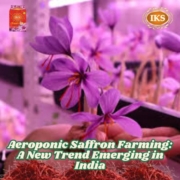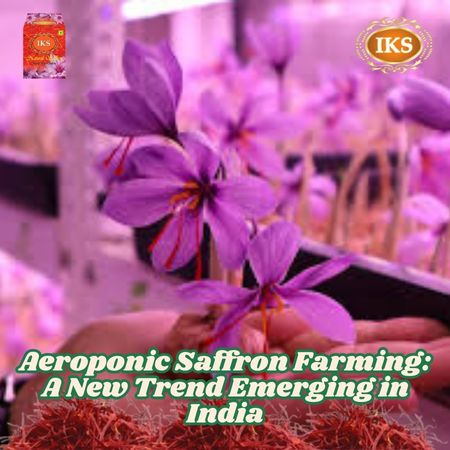Aeroponic Saffron Farming: A New Trend Emerging in India – Can It Compete with the Authentic Aroma of Kashmiri Kesar
Aeroponic Saffron Farming: A New Trend Emerging in India – Can It Compete with the Authentic Aroma of Kashmiri Kesar
Aeroponic Saffron Farming – Saffron (also known as Zaffran, Kesar, Kungumapoo, Kumkuma Puvvu, Kumkumpuvvu etc.), often hailed as “red gold,” stands as one of the most valuable and coveted spices globally. Celebrated for its distinctive aroma, vibrant hue, and numerous medicinal benefits, Kashmiri saffron is widely regarded as the finest variety in the world.
Recently, India has seen the rise of a groundbreaking trend – aeroponic saffron farming. This modern cultivation technique has garnered significant attention from farmers and saffron enthusiasts, particularly those eager to grow saffron bulbs in controlled environments.
At India Kashmir Saffron (IKS), we receive between 10 to 50 inquiries daily regarding saffron bulbs and aeroponic farming practices. However, a critical question lingers: Can aeroponic saffron truly replicate the authentic aroma, quality, and essence of naturally grown Kashmiri saffron? Let’s dive deeper into this intriguing debate.
Taste the Difference – Experience the authentic aroma of Kashmiri Kesar. Shop organic saffron online now!
What is Aeroponic Saffron Farming?
Aeroponic farming is an innovative, soilless cultivation technique that allows plants to thrive in an air or mist environment. In this method, the roots are suspended in the air and receive nourishment through a nutrient-rich mist. This approach is becoming increasingly popular due to its efficiency, water-saving advantages, and capacity to grow crops in controlled settings.
When it comes to saffron, aeroponic farming focuses on cultivating saffron bulbs (corms) in a soil-free environment. This technique is especially attractive to farmers in areas where the natural climate and soil conditions are not conducive to traditional saffron cultivation.
Why is Aeroponic Saffron Farming Trending in India?
Aeroponic saffron farming is rapidly gaining attention in India, and for good reason. This innovative cultivation technique is attracting farmers, entrepreneurs, and even hobbyists who are eager to explore sustainable and efficient methods for growing saffron. Here are the key factors driving this trend:
1. High Demand for Saffron Bulbs
India has seen a surge in interest in saffron cultivation, with farmers and enthusiasts actively seeking high-quality saffron bulbs (corms) to start their own ventures. At India Kashmir Saffron (IKS), there has been a significant rise in inquiries, with 10 to 50 calls daily from people curious about aeroponic farming and sourcing saffron bulbs. This growing demand highlights the eagerness of individuals to experiment with modern agricultural techniques that promise higher efficiency and yield.
2. Controlled Growth Environment
One of the key benefits of aeroponic systems is the ability to create a fully controlled environment for cultivation. Farmers can precisely regulate critical factors like temperature, humidity, light exposure, and even nutrient delivery, all of which are essential for saffron growth. This is particularly advantageous in regions where the natural climate is unsuitable for traditional saffron farming. By eliminating reliance on external weather conditions, aeroponic farming ensures consistent production throughout the year.
3. Water Efficiency
Water scarcity is a pressing issue in many parts of India, making water-efficient farming methods more relevant than ever. Aeroponic systems use up to 90% less water compared to traditional soil-based farming methods. This sustainability factor makes aeroponic saffron farming an eco-friendly choice, appealing to farmers looking to reduce their environmental footprint while maintaining productivity.
4. Space-Saving Advantage
Aeroponic farming setups can be designed to utilize vertical growing systems, making them ideal for urban areas or locations with limited agricultural space. This space-saving feature enables farmers to grow more saffron in a smaller area, making aeroponic farming a practical solution for both small-scale hobbyists and large-scale commercial ventures. Urban farmers, in particular, are exploring this method to cultivate saffron in indoor or rooftop farms, bringing agriculture closer to cities.
Celebrate Authenticity – While aeroponic saffron farming grows, savor the unmatched quality of Kashmiri Kesar. Order organic saffron online!
The Challenge: Can Aeroponic Saffron Match the Aroma of Natural Kashmiri Saffron?
While aeroponic saffron farming brings numerous advantages, such as efficiency, sustainability, and scalability, it faces one critical challenge: Can it truly replicate the unparalleled aroma, flavor, and quality of naturally grown Kashmiri saffron? The answer lies in understanding the unique factors that make Kashmiri saffron so exceptional.
The Role of Kashmir’s Climate and Soil
Kashmiri saffron owes its unique properties to the distinctive natural environment of the Kashmir Valley, particularly in the Pampore region, often called the saffron capital of the world. Here’s what makes Kashmir’s climate and soil so special:
- Cold Winters and Moderate Rainfall: The region experiences cold winters and a temperate climate with moderate rainfall, creating ideal conditions for saffron corms to thrive.
- Well-Drained Soil: Kashmir’s soil is rich in organic matter and known for its excellent drainage, which is crucial for preventing waterlogging—a condition harmful to saffron plants.
- Altitude and Microclimate: The Pampore region’s altitude and distinct microclimate enhance the biochemical properties of saffron, resulting in deep red stigmas, a strong aroma, and a high crocin content (the compound responsible for saffron’s vivid color and health benefits).
These natural factors work in harmony, producing saffron that is celebrated worldwide for its potency, aroma, and flavor—qualities that are difficult to replicate outside this unique ecosystem.
Aeroponic Saffron vs. Natural Kashmiri Saffron
Even though aeroponic saffron farming offers controlled environments where factors like temperature, humidity, and lighting can be precisely regulated, it still falls short of replicating Kashmir’s natural terroir. Here’s why:
- Lack of Soil Interaction: The soil in Kashmir plays a vital role in shaping the flavor and aroma of saffron. It contains unique minerals and organic compounds that interact with the saffron bulbs, influencing their chemical composition. In aeroponic systems, where soil is absent, this interaction is entirely missing.
- Altitude and Natural Ecosystem: Kashmir’s altitude and open-air ecosystem contribute to saffron’s unique profile. Aeroponic systems, regardless of their technological advancements, cannot replicate the natural air pressure, sunlight intensity, or climatic variations of the region.
- Flavor and Aroma Profiles: While saffron bulbs sourced from Kashmir can be used in aeroponic farming, the final product may not achieve the same intensity of aroma and flavor. This is because saffron’s chemical compounds, such as crocin (color), picrocrocin (taste), and safranal (aroma), are directly influenced by the environment in which it is cultivated. Without the natural soil and climate of Kashmir, the saffron produced may lack the depth and richness that distinguishes Kashmiri saffron.
- Cultural and Historical Significance: Beyond its physical attributes, Kashmiri saffron carries a legacy rooted in centuries of traditional farming practices, which adds to its value and allure. Aeroponic saffron, being a modern innovation, does not carry the same cultural and historical significance.
Can Aeroponic Saffron Compete?
While aeroponic saffron farming is an exciting innovation that makes saffron cultivation more accessible and sustainable, it is unlikely to fully replicate the authentic aroma, flavor, and quality of natural Kashmiri saffron.
However, this does not diminish its potential; aeroponic farming allows saffron to be grown in regions where traditional cultivation is impossible and offers a scalable solution to meet growing demand.
That said, for connoisseurs and purists, the saffron grown in the natural soil and climate of Kashmir will likely remain irreplaceable—a testament to the magic of nature that no technology can entirely replicate.
Shop the Gold Standard – Dive into the world of saffron farming and bring home authentic, organic Kashmiri saffron. Buy online now!
A Detailed Comparison: Kashmiri Saffron vs. Iranian Saffron
When it comes to saffron, two names often dominate the conversation: Kashmiri saffron and Iranian saffron. While Iran is the largest producer of saffron globally, contributing to over 90% of the world’s saffron production, Kashmiri saffron holds a unique and prestigious position due to its exceptional quality, rich aroma, and medicinal properties. Let’s explore the key differences between these two saffron varieties and understand what sets them apart.
1. Aroma and Flavor
- Kashmiri Saffron: Known for its intense aroma and slightly sweet flavor, Kashmiri saffron is highly prized by chefs, connoisseurs, and health enthusiasts. The presence of higher levels of safranal (the compound responsible for aroma) gives Kashmiri saffron its distinct fragrance, which is more robust and long-lasting compared to its Iranian counterpart. Its flavor is rich and complex, making it a preferred choice for culinary and medicinal applications.
- Iranian Saffron: While Iranian saffron is also aromatic, its fragrance is generally milder and subtler than Kashmiri saffron. Similarly, its flavor profile is less intense, which may appeal to those who prefer a more delicate saffron taste. However, for dishes that rely heavily on saffron’s aroma and flavor, Iranian saffron may not provide the same depth as Kashmiri saffron.
2. Color and Crocin Content
- Kashmiri Saffron: One of the most distinguishing features of Kashmiri saffron is its deep red color, which is a result of its high crocin content. Crocin is the compound responsible for saffron’s vibrant color and is also linked to its medicinal properties. The deeper red hue of Kashmiri saffron not only enhances its visual appeal but also reflects its superior quality and potency. When used in cooking, even a small amount of Kashmiri saffron imparts a rich golden color to dishes.
- Iranian Saffron: Iranian saffron, while vibrant, typically has a slightly lighter red or orange hue compared to Kashmiri saffron. This is because its crocin content is generally lower. As a result, Iranian saffron may require a larger quantity to achieve the same intensity of color in culinary applications.
3. Medicinal Properties
- Kashmiri Saffron: Often considered the gold standard for medicinal benefits, Kashmiri saffron is rich in compounds like crocin, picrocrocin, and safranal, which contribute to its anti-inflammatory, antioxidant, and mood-enhancing properties. It has been traditionally used in Ayurveda and other holistic medicine systems to treat ailments like depression, digestive disorders, and skin conditions. Its potency makes it a preferred choice for therapeutic use.
- Iranian Saffron: While Iranian saffron also contains medicinal compounds like crocin and safranal, their concentration is generally lower than in Kashmiri saffron. This makes it slightly less effective for medicinal purposes, though it is still widely used for its health benefits. Iranian saffron is more commonly used in culinary applications rather than as a primary ingredient in herbal medicines.
4. Yield and Production
- Iranian Saffron: Iran produces over 90% of the world’s saffron, making it the largest exporter by far. Its production is highly industrialized and geared toward mass production and export. Iranian saffron is often more affordable and readily available in global markets, which explains its widespread use.
- Kashmiri Saffron: In contrast, Kashmiri saffron is produced in limited quantities, primarily in the Pampore region of Jammu and Kashmir, which is often referred to as the “Saffron Bowl of India.” The smaller-scale production, combined with the labor-intensive cultivation process and unique environmental factors, makes Kashmiri saffron rarer and more expensive. Its limited availability adds to its exclusivity and prestige.
5. Natural Environment and Cultivation
- Kashmiri Saffron: The unique climatic and soil conditions of Kashmir play a pivotal role in shaping the quality of its saffron. The region’s cold winters, moderate rainfall, and well-drained soil, along with its altitude and microclimate, create the perfect conditions for saffron cultivation. These natural factors are impossible to replicate, making Kashmiri saffron truly one-of-a-kind.
- Iranian Saffron: Iran’s saffron is cultivated in hot, arid regions with minimal rainfall. While these conditions are suitable for saffron farming, they do not impart the same depth of flavor, aroma, and color as the cooler, organic-rich soils of Kashmir. However, Iran’s large-scale production capabilities allow it to meet the growing global demand for saffron.
6. Price and Prestige
- Kashmiri Saffron: Due to its limited production, superior quality, and the labor-intensive harvesting process, Kashmiri saffron is significantly more expensive than Iranian saffron. Each stigma is carefully handpicked, dried, and processed to maintain its quality. Its price reflects its exclusivity and the cultural significance it holds in India.
- Iranian Saffron: Iranian saffron is often more affordable, making it a popular choice for everyday use. Its mass production and availability in bulk quantities make it accessible to a wider audience, but it lacks the same level of prestige as Kashmiri saffron.
5 GRAMS 100% FRESH PURE ORIGINAL AUTHENTIC PREMIUM TOP BEST HIGH QUALITY A+++ GRADE IKS KASHMIRI SAFFRON (KESAR / KUMKUMA PUVVU / KUNGUMAPOO / KUMKUMPUVVU / ZAFFRAN)
Final Thoughts: Is Aeroponic Saffron Farming Worth It?
Aeroponic saffron farming represents a bold step forward in agricultural innovation, offering a modern solution to some of the challenges associated with traditional saffron cultivation. It is especially promising for regions where growing saffron naturally is not feasible due to unsuitable climate, poor soil quality, or limited agricultural space. With its water efficiency, space-saving vertical setups, and controlled conditions, aeroponic farming has the potential to make saffron cultivation more accessible and sustainable.
However, it’s equally important to manage expectations and understand the limitations of this method. While aeroponic systems can successfully grow saffron, the final product may not fully replicate the aroma, flavor, and quality of naturally grown Kashmiri saffron, which is widely regarded as the best in the world.
The Unique Superiority of Kashmiri Saffron
Kashmiri saffron owes its remarkable characteristics to the distinctive natural environment of the Kashmir Valley. The cold winters, moderate rainfall, well-drained soil, altitude, and microclimate work together in perfect harmony to produce saffron with its intense aroma, deep red color, and rich flavor profile. These natural factors are impossible to fully replicate in any controlled system, including aeroponics.
Even if saffron bulbs (corms) used in aeroponic farming are sourced from Kashmir, the absence of Kashmir’s unique terroir means that the chemical composition of the saffron may differ. Compounds like safranal (aroma), crocin (color), and picrocrocin (flavor), which define saffron’s quality, are heavily influenced by the natural ecosystem. As a result, aeroponic saffron might lack the depth and authenticity that Kashmiri saffron is celebrated for.
At India Kashmir Saffron (IKS), we believe in preserving and celebrating the authenticity of Kashmiri saffron, a product of centuries-old farming traditions and the unique natural environment of the Kashmir Valley. While we recognize the potential of aeroponic farming to revolutionize saffron cultivation, we also acknowledge that no technology can fully replicate the magic of nature.
In conclusion, aeroponic saffron farming is worth it for those seeking innovation and sustainability, but for the true connoisseurs of saffron, the authentic aroma, flavor, and quality of naturally grown Kashmiri saffron remain irreplaceable.
Sustainability Meets Flavor – Indulge in authentic organic Kashmiri saffron. Shop online now!








Leave a Reply
Want to join the discussion?Feel free to contribute!